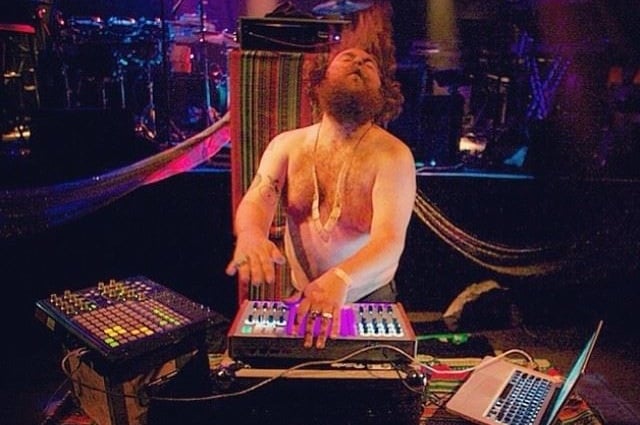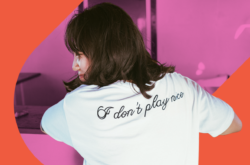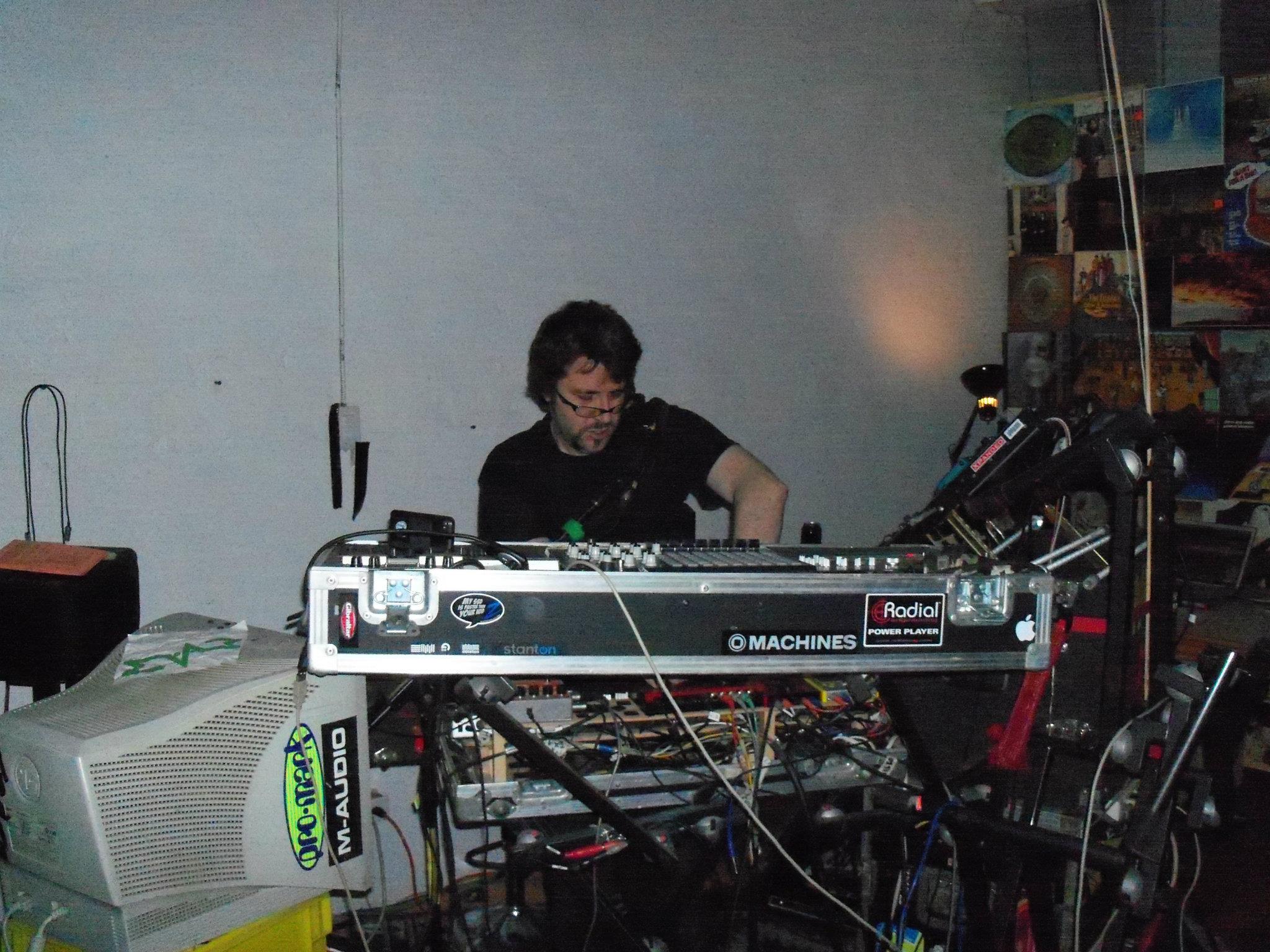Lapalux, alias of English producer Stuart Howard, creates music plucked from the uncanny valley.
Haunting textural glitches and industrial sounds sway with brashness to a dizzying effect – yet, like a ray of light peeking through a storm, synth, melody, and harmony envelop his records into lush, dreamlike states. His sample pack similarly navigates this through line of dichotomy, blurring the lines of harsh and gorgeous, discordant and harmonious, and digital and human. Following the release of his sample pack, we chatted with Lapalux about his modular setups, manipulating and warping sounds, and bringing life to digital sounds.
1. To start, can you give us a walkthrough of your studio? What is your current setup in terms of hardware, software, instruments, interfaces, monitors, etc.? Guide us through what tools you use to create – you’ve begun to incorporate quite a bit more analog and modular equipment into your work, correct?
Yes, over the past couple years I’ve been building my modular system slowly. I’ve really gotten into it – the fact that you can create your own strange instrument and think about creating music in a completely different way was the main reason I started building it. Alongside that, I have a Korg Polysix, Elektron Rytm, Dave Smith Prophet 6, a bunch of cassette tape recorders, and also a bunch of effects like a couple Eventide pedals and some other bits. I run it all into a UAD soundcard which allows me to further process all the sounds with the onboard effects, which are really great.
2. Your earlier work was centered around intensive, colorful, and expansive sound collages, but these days, your music is far more stripped down. Take us through how your process changed from then to now. Do you think your approach and how you think about sound design is the same (albeit your tools are now different), or was this a deliberate attempt to step away from that sound and that era?
In my earlier work, I was really into the idea of maximalism and layering tracks up to create a kind of sonic wall of sound. I think later on with Lustmore and Ruinism I started really trimming the fat and focusing on each individual sound and whether that sound deserves the place it has in the music. I’ve become more and more detailed and focused in my production techniques and I’m always learning new things about sound and processing sound. I have to feel something in the sound that I create, like emotionally. Once I feel that I’m connected to the sound, then I try and find other sounds that meet that same feeling and build the track from there. It’s always been that way for me. I like to pour everything I have into my music because for me, that’s my release and my way of escape.
3. What kind of processing (VSTs, plugins, hardware, etc.) do you typically abide by? Do you use any specific gear for FX and glitch textures – any particular distortion, stutter plugins, etc.?
I use a lot of the UAD plugins for processing hardware. I think they sound phenomenal if you don’t go too overboard with them. I have a bunch of guitar pedals that I have on a send/return bus on my mixer which I add to the mix. I usually record all my audio with the outboard effects on them, and then I’ll play around further with whatever I’ve recorded with software. A lot of my gear buzzes and makes some strange noises sometimes, and for me that’s the best part of using hardware. The little moments when my Polysix slips in and out of tune, or when my modular spits out some unexpected sound or sequence while I’m setting it up to generate some strange idea – these are the moments I thrive off of. My textural stuff is usually recordings that I’ve taken on my portable recorder and heavily effected with plugins and outboard effects. I’m quite old school when it comes to creating glitches and stuttering patterns – I usually do it by hand in the Ableton arrangement view.
4. How has your synth work developed over the years? What’s your current setup, and do you have specific go-tos for leads, bass, pads, etc.?
I would say that a lot of lead sounds come from the Polysix (that is, if it’s actually working on the day), but I also use it for a lot of nice chordal stuff too. For bass, I tend to lean toward the modular; there’s a lot of depth and color to the frequencies the modular gear kicks out. Also, this little module I’ve started using live called Basimilus Iteritas Alter by Noise Engineering spits out some crazy sub-y wave-folding shit if you use it right. I’ve started using that a lot more in my studio now, too. To be honest though, I flit between all of my gear and use them all on every part of the track. For instance, I was working on a track the other day and I managed to set a sequence on my Prophet 6 that was this strange percussive loop I recorded. Likewise, I might take my guitar and bow it with a violin bow. I can hit this table I’m sitting at right now in a certain way, and it can become the kick drum or a bass stab for something.
5. Can you tell us about creating your sample pack and working with the Elektron hardware series? How did you find the process of creating your own sample pack? How has your workflow changed (or not changed) with the use of sampling?
I tend to sample and re-sample a lot of my equipment day-to-day, so the process of working on the pack itself was quite a simple one. All the drums for the pack were programmed and then taken straight off of the Elektron RYTM. All the onboard effects in that machine are great. A lot of the kits have a roughness to them. Using the onboard distortion helped saturate the sound and gave the kits a real punch. I set aside a lot of time to really get into a piece of hardware to find out all the interesting ways it could be used or manipulated. I think there’s something very freeing about narrowing down your options to one or two bits of gear – it allows you to focus and really push the hardware to its limits.
6. The intersection of technology and humanism is one thing I take away from your music, where metallic textures and warped vocals are paired so frequently with gorgeous, emotive synthesizers and soundscapes. How do you explore the blurred line between digital and human in your work? Especially when working so diligently in the worlds of modular and analog hardware, how do you maintain a human touch?
The blurring between human and digital/analogue is always something that I’m trying to achieve. I can’t stand static, over-produced sounds. It has to have that warmth, depth, and emotion for me. One example is if I’m recording the modular, I’ll set it up to be just slightly out of tune and warbly in pitch, and have several elements of that sound or sequence running through various send and return channels with various effects on each part to get that thick, lush characteristic. I think a lot of what I do is, like I mentioned before, based on feeling. I have a special bond to the sounds that I create and I know when something sounds good or bad to me. It’s as simple as that, really. Sometimes it all comes together, and other times I can go days or weeks without anything clicking. There’s a feeling I can’t quite explain – when I hear something that just works.
Can you share with us the things that embody your creative process and give you inspiration? Whether it’s technical, atmospheric, ritualistic, emotional, etc. – we want to know what you need to fuel your creativity and what keeps you inspired.
Visual stimulation is probably the most important inspiration to me. That and the emotional attachment to my thoughts and feelings. Sometimes it’s hard to express myself with words, so for me music is my outlet. Visually, I’ll usually find an image or take a photo of something and write the music to that in a sort of ‘what is that picture trying to say to me sonically’ kind of way. That and a lot of films and videos I find help me a lot in the writing stages of music. It also comes down to where I am mentally and physically.
October 19, 2018



